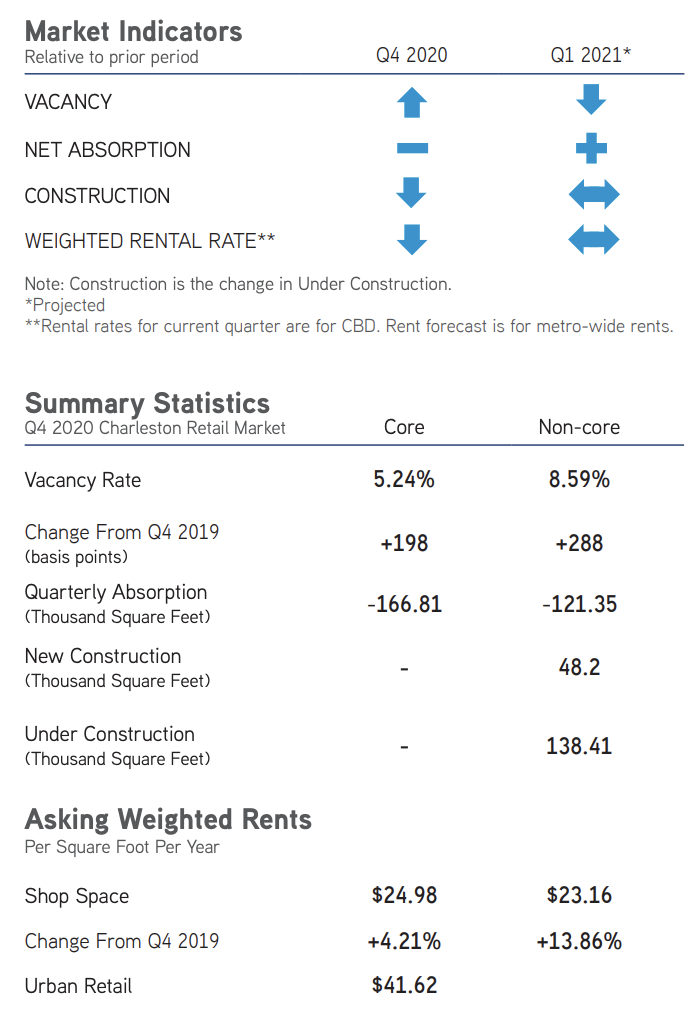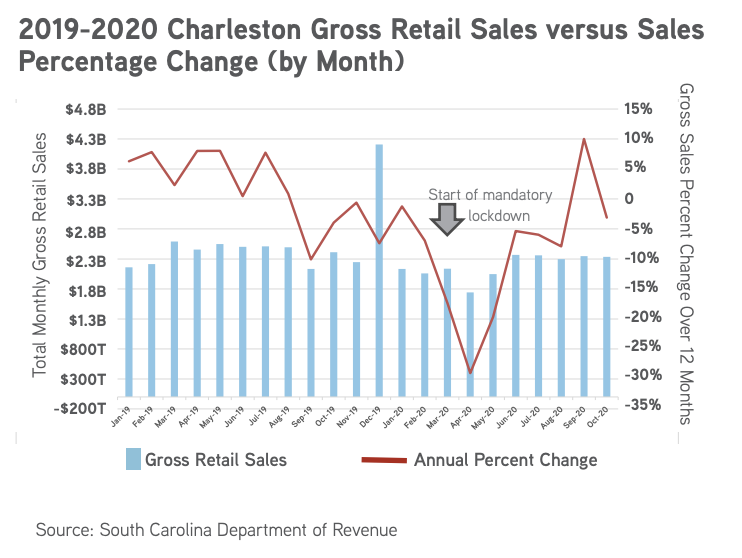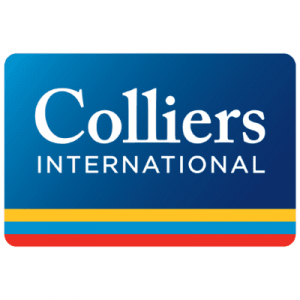Colliers Report: Charleston gross retail sales rebounding as retailers adopt new business operations
February 8, 2021
Research & Forecast Report
Q4-2020 CHARLESTON | RETAIL
Key Takeaways
- Despite a downward spike in retail sales at the start of the pandemic, Charleston gross retail sales have rebounded strongly as businesses adapt business practices to meet consumer needs.
- A shift to client-centric operations is prompting retailers to adapt their business lay-outs.
- As tourism and vacationing resumes, Charleston market activity is expected to pick-up next year.
To download the complete report: 2020 Q4 Retail Charleston Report
Client-centric options are leading to adaptive business plans
 One thing the pandemic has taught us: food is essential, mobile and can be eaten anywhere, so long as it is available. Therefore, trends are evolving to meet consumers at their comfort level. The major shift this year was from restaurant-centric preferences of service to consumer-centric preferences in an effort to ensure a restaurant’s full menu is accessible to as many consumers as possible. Quick service restaurants (QSRs) choosing to decrease restaurant space began pre-pandemic, around 2016; however, the pandemic furthered the trend of QSRs focusing on leasing or developing space with one or more drive-thru options available. Restaurants that do not already have them are planning to install them, and those that have one are often planning to add more. In addition, many restaurants are opting for a reduced footprint for indoor dining, but allowing planning for larger outdoor seating areas and additional pick-up options in the carry-out portion of the restaurant. Less dine-in space has not only led to several drive-thrus, restaurateurs are getting creative with consumer options for food pick up. Curbside pick-up is popular so consumers do not have to get out of their car in order to pick up their pre-ordered food. Those that do not mind getting out of their car but prefer not to interact with anyone have the option of enclosed kiosks with to go prepaid orders in them-clients can pick up their food with no face-to-face contact. Delivery services are extending restaurant delivery areas to a larger radius of clients in the region. While many restaurants and retailers managed to stay partially open throughout the pandemic, the successful ones continue to adapt their business practices to deliver their goods in a safe and efficient manner to all consumers.
One thing the pandemic has taught us: food is essential, mobile and can be eaten anywhere, so long as it is available. Therefore, trends are evolving to meet consumers at their comfort level. The major shift this year was from restaurant-centric preferences of service to consumer-centric preferences in an effort to ensure a restaurant’s full menu is accessible to as many consumers as possible. Quick service restaurants (QSRs) choosing to decrease restaurant space began pre-pandemic, around 2016; however, the pandemic furthered the trend of QSRs focusing on leasing or developing space with one or more drive-thru options available. Restaurants that do not already have them are planning to install them, and those that have one are often planning to add more. In addition, many restaurants are opting for a reduced footprint for indoor dining, but allowing planning for larger outdoor seating areas and additional pick-up options in the carry-out portion of the restaurant. Less dine-in space has not only led to several drive-thrus, restaurateurs are getting creative with consumer options for food pick up. Curbside pick-up is popular so consumers do not have to get out of their car in order to pick up their pre-ordered food. Those that do not mind getting out of their car but prefer not to interact with anyone have the option of enclosed kiosks with to go prepaid orders in them-clients can pick up their food with no face-to-face contact. Delivery services are extending restaurant delivery areas to a larger radius of clients in the region. While many restaurants and retailers managed to stay partially open throughout the pandemic, the successful ones continue to adapt their business practices to deliver their goods in a safe and efficient manner to all consumers.
Annual Market Recap
 The Charleston retail market thrives on tourism; therefore, this year has been tough for retailers in the region. Once the pandemic hit and travel bans were imposed, many retailers shut down. The lack of tourists to purchase goods made it a challenge to remain open. Despite a downward spike in retail sales at the start of the pandemic, Charleston retail sales have rebounded strongly and businesses are opening to consumers ready to purchase goods. Throughout 2020, there were 70,060 square feet of non-core retail space delivered to the market and 20,280 square feet of core space. Some of the newly-delivered space was vacant contributing to Charleston retail submarkets posting a net negative 205,753 square feet of absorption. Therefore, the overall market vacancy rate increased by 209 basis points from year-end 2019 through year-end 2020.
The Charleston retail market thrives on tourism; therefore, this year has been tough for retailers in the region. Once the pandemic hit and travel bans were imposed, many retailers shut down. The lack of tourists to purchase goods made it a challenge to remain open. Despite a downward spike in retail sales at the start of the pandemic, Charleston retail sales have rebounded strongly and businesses are opening to consumers ready to purchase goods. Throughout 2020, there were 70,060 square feet of non-core retail space delivered to the market and 20,280 square feet of core space. Some of the newly-delivered space was vacant contributing to Charleston retail submarkets posting a net negative 205,753 square feet of absorption. Therefore, the overall market vacancy rate increased by 209 basis points from year-end 2019 through year-end 2020.
Market Conditions
 The Charleston retail market consists of approximately 14.49 million square feet of retail space and posted a negative absorption of 288,160 square feet during the fourth quarter of 2020. It was almost evenly split between core and non-core retail space. Positive absorption occurred within the West Ashley submarket- almost all, of which, was within core shops. There are currently 138,410 square feet of retail properties under construction throughout Charleston non-core areas. According to Costar, overall market weighted shop rental rates averaged approximately $23.79 per square foot.
The Charleston retail market consists of approximately 14.49 million square feet of retail space and posted a negative absorption of 288,160 square feet during the fourth quarter of 2020. It was almost evenly split between core and non-core retail space. Positive absorption occurred within the West Ashley submarket- almost all, of which, was within core shops. There are currently 138,410 square feet of retail properties under construction throughout Charleston non-core areas. According to Costar, overall market weighted shop rental rates averaged approximately $23.79 per square foot.
Market Forecast
Adapting retail shops and restaurants to cater to consumers and their pick-up preferences will continue to boost sales throughout the Charleston market. In addition, medical clinics, home goods, drug stores, convenience stores and grocery-anchored shopping centers are likely to have the most market activity in the next few quarters. Activity will begin to normalize with the vaccine roll-out. As tourism and vacationing resumes, Charleston market activity is expected to soar during the third quarter of 2021. In addition, consumers are ready to shop in stores instead of ordering everything online. With consumers eager to get out of their houses and enjoy experiential retail and vacation hotspots, Charleston ranks at the top of the list of places to go.
A Note Regarding COVID-19
As we publish this report, the U.S. and the world at large are facing a tremendous challenge, the scale of which is unprecedented in recent history. The spread of the novel Coronavirus (COVID-19) is significantly altering day-to-day life, impacting society, the economy and, by extension, commercial real estate.
The extent, length and severity of this pandemic is unknown and continues to evolve at a rapid pace. The scale of the impact and its timing varies between locations. To better understand trends and emerging adjustments, please subscribe to Colliers’ COVID-19 Knowledge Leader page for resources and recent updates.
For additional commercial real estate news, check out our market reports here.
To download the complete report: 2020 Q4 Retail Charleston Report














